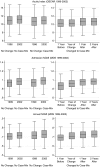The effect of state medicaid case-mix payment on nursing home resident acuity
- PMID: 16899009
- PMCID: PMC1797088
- DOI: 10.1111/j.1475-6773.2006.00545.x
The effect of state medicaid case-mix payment on nursing home resident acuity
Erratum in
- Health Serv Res. 2006 Aug;41(4 Pt 1):1337
Abstract
Objective: To examine the relationship between Medicaid case-mix payment and nursing home resident acuity.
Data sources: Longitudinal Minimum Data Set (MDS) resident assessments from 1999 to 2002 and Online Survey Certification and Reporting (OSCAR) data from 1996 to 2002, for all freestanding nursing homes in the 48 contiguous U.S. states.
Study design: We used a facility fixed-effects model to examine the effect of introducing state case-mix payment on changes in nursing home case-mix acuity. Facility acuity was measured by aggregating the nursing case-mix index (NCMI) from the MDS using the Resource Utilization Group (Version III) resident classification system, separately for new admits and long-stay residents, and by an OSCAR-derived index combining a range of activity of daily living dependencies and special treatment measures.
Data collection/extraction methods: We followed facilities over the study period to create a longitudinal data file based on the MDS and OSCAR, respectively, and linked facilities with longitudinal data on state case-mix payment policies for the same period.
Principal findings: Across three acuity measures and two data sources, we found that states shifting to case-mix payment increased nursing home acuity levels over the study period. Specifically, we observed a 2.5 percent increase in the average acuity of new admits and a 1.3 to 1.4 percent increase in the acuity of long-stay residents, following the introduction of case-mix payment.
Conclusions: The adoption of case-mix payment increased access to care for higher acuity Medicaid residents.
Figures
Similar articles
-
Nursing home performance under case-mix reimbursement: responding to heavy-care incentives and market changes.Health Serv Res. 1998 Oct;33(4 Pt 1):815-34. Health Serv Res. 1998. PMID: 9776938 Free PMC article.
-
Medicaid payment rates, case-mix reimbursement, and nursing home staffing--1996-2004.Med Care. 2008 Jan;46(1):33-40. doi: 10.1097/MLR.0b013e3181484197. Med Care. 2008. PMID: 18162853
-
Effect of prospective reimbursement on nursing home costs.Health Serv Res. 1993 Apr;28(1):45-68. Health Serv Res. 1993. PMID: 8463109 Free PMC article.
-
A systematic review of case-mix models for home health care payment: Making sense of variation.Health Policy. 2020 Feb;124(2):121-132. doi: 10.1016/j.healthpol.2019.12.012. Epub 2020 Jan 2. Health Policy. 2020. PMID: 31928858
-
An Overview of International Staff Time Measurement Validation Studies of the RUG-III Case-mix System.Health Serv Insights. 2019 Feb 24;12:1178632919827926. doi: 10.1177/1178632919827926. eCollection 2019. Health Serv Insights. 2019. PMID: 30828247 Free PMC article. Review.
Cited by
-
National newspaper portrayal of U.S. nursing homes: periodic treatment of topic and tone.Milbank Q. 2012 Dec;90(4):725-61. doi: 10.1111/j.1468-0009.2012.00681.x. Milbank Q. 2012. PMID: 23216429 Free PMC article.
-
Racial/Ethnic Disparities in Nursing Home Quality of Life Deficiencies, 2001 to 2011.Gerontol Geriatr Med. 2016 Jun 6;2:2333721416653561. doi: 10.1177/2333721416653561. eCollection 2016 Jan-Dec. Gerontol Geriatr Med. 2016. PMID: 27819015 Free PMC article.
-
The effect of political control on financial performance, structure, and outcomes of US nursing homes.Health Serv Res. 2019 Feb;54(1):167-180. doi: 10.1111/1475-6773.13061. Epub 2018 Oct 8. Health Serv Res. 2019. PMID: 30294780 Free PMC article.
-
Medicare Advantage enrollees' use of nursing homes: trends and nursing home characteristics.Am J Manag Care. 2018 Aug 1;24(8):e249-e256. Am J Manag Care. 2018. PMID: 30130025 Free PMC article.
-
How Neighborhood Social Deprivation Is Associated With Nursing Home Quality: A Structure, Process, Outcome Model.Innov Aging. 2025 Jan 10;9(2):igaf004. doi: 10.1093/geroni/igaf004. eCollection 2025. Innov Aging. 2025. PMID: 39963524 Free PMC article.
References
-
- Bishop C E. Where Are the Missing Elders? The Decline in Nursing Home Use, 1985 and 1995. Health Affairs (Millwood) 1999;18(4):146–55. - PubMed
-
- Burwell B, Sredl K, Eiken S. Medicaid Long Term Care Expenditures in FY 2004. 2005. [March 20, 2006]. Medstat. Available at http://www.hcbs.org/moreInfo.php/topic/207/sby/Author/lim/ALL/doc/1260/M....
-
- Butler P A, Schlenker R E. Case-Mix Reimbursement for Nursing Homes: Objectives and Achievements. Milbank Quarterly. 1989;67(1):103–36. - PubMed
-
- Carter G M, Newhouse J P, Relles D A. How Much Change in the Case Mix Index Is DRG Creep? Journal of Health Economics. 1990;9(4):411–28. - PubMed
Publication types
MeSH terms
Grants and funding
LinkOut - more resources
Full Text Sources
Medical
Research Materials
Miscellaneous


